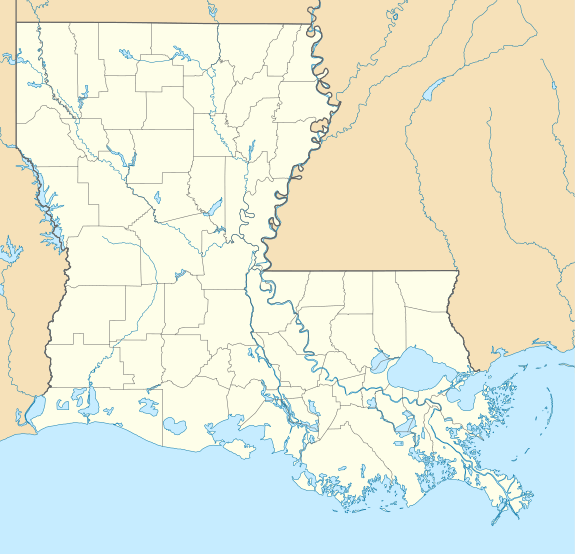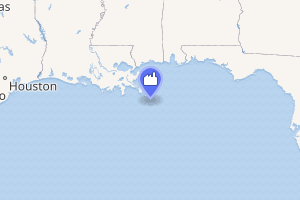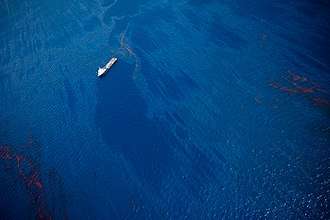Taylor oil spill
The 2004 Taylor oil spill is an ongoing spill located in the Gulf of Mexico, around 11 miles (18 km) off the coast of the U.S. state of Louisiana, which resulted from the destruction of a Taylor Energy oil platform during Hurricane Ivan, and it is the longest oil spill in U.S. history.[2] It was first brought to public attention when the contamination at the site was noticed in 2010 by those monitoring the nearby Deepwater Horizon oil spill. A later report by the Associated Press in 2015 challenged the estimates of the extent of the leak given by the company and the U.S. Coast Guard, which were then revised to be around 1000 times greater than initially reported.
| Taylor oil spill | |
|---|---|
 Location of the Taylor oil spill, off the southeast coast of Louisiana | |

| |
| Location | Gulf of Mexico |
| Coordinates | 28°56′09″N 88°58′12″W[1] |
| Date | 2004 – 2019 |
| Cause | |
| Cause | Hurricane |
| Operator | Taylor Energy |
| Spill characteristics | |
| Volume | 1,400,000 US gallons (5,300,000 l; 1,200,000 imp gal) (upper 2015 estimate) |
| Area | 8 square miles (21 km2) |
| Shoreline impacted | Gulf Coast of the United States |
Upper estimates of the spill have been calculated to be as much as 1,400,000 US gallons (5,300,000 l; 1,200,000 imp gal) of oil lost over the life of the disaster, affecting an area as large as 8 square miles (21 km2). As of 2018, it was estimated that 300 to 700 barrels of oil per day are being spilled, making it one of the worst modern oil spills in the Gulf of Mexico by volume. The reserves are likely sufficient for the spill to continue for up to 100 years if it is not contained.
Taylor Energy has spent as much as $435 million or more decommissioning the site. They contend that nothing further can be done to contain the spill, and that current observations of oil plumes in the area are the result of contaminated sediments, and not an active spill. This has been contradicted by the reports of non-profit groups, the press, and the government.
Origin
The Taylor Energy Mississippi Canyon 20 site[lower-alpha 1] was constructed in 1984, 11 miles (18 km) southeast of the Plaquemines-Balize delta. It consisted of a "fixed, 8-pile structure" in 490 feet (150 m) deep water, with 28 wells reaching reservoirs of depths of up to 2.08 miles (3.35 km).[3]
In September 16, 2004, Hurricane Ivan passed within 62 miles (100 km) of the site, and caused submarine landslides that capsized the drill rig and moved it 560 feet (170 m) from its original location.[3][4] This resulted in between 25 and 28 leaking wells being buried beneath the sea floor, approximately 475 feet (145 m) below the surface.[5][6][7]
Public awareness
According to The Washington Post, although Taylor Energy reported the spill to the Coast Guard at the time, the Coast Guard "monitored the site for more than half a decade without making the public fully aware" of the severity of the leak.[6] Increased attention later came in 2010, when observers monitoring the Deepwater Horizon oil spill discovered a persistent oil slick at the Taylor site.[6]
The Louisiana Environmental Action Network and several other conservationist organizations sued Taylor Energy in 2012, alleging that they, along with the federal government had withheld information from the public in a way that was "inconsistent with national policy", specifically a provision of the Clean Water Act, which mandates "public participation in the ... enforcement of any regulation".[6][8]
In 2015 the Associated Press conducted an investigation into the spill, and when provided with their results, the Coast Guard updated their leak estimates to one that was "about 20 times greater than one recently touted by the company".[6][9] Additional information regarding the spill has been withheld by the company, with the approval of the government, in the "name of protecting trade secrets".[9]
As of 2018, the National Oceanic and Atmospheric Administration (NOAA) was three years behind a deadline for producing a study of the environmental impacts of the spill. In July 2018, the non-profit Earthjustice filed a lawsuit against NOAA for "failing to produce a timely study".[6] As of 2018 no economic impact analysis of the spill had been conducted.[6]
Magnitude

As of October 2018, it was estimated that between 300 and 700 barrels of oil per day were being spilled near the Taylor Energy site. In May 2019, the US Coast Guard installed a containment system that has been collecting 30 barrels per day.[10] As of June 2019, a report by the National Center for Coastal Ocean Science estimated that the flow rate of oil leaking at the site was between 9 and 108 barrels per day.[11] The resulting oil sheen was estimated in 2015 to cover 8 square miles (21 km2).[6][12] As of 2014, the sheen was approximately 1.5 miles (2.4 km) wide and 14 miles (23 km) long, with an average of 1 mile (1.6 km) wide and 5.5 miles (8.9 km) long.[5]
Estimates by the environmental non-profit group SkyTruth indicated that the spill may have emptied up to 1,400,000 US gallons (5,300,000 l; 1,200,000 imp gal) of oil as of 2015, making it the 8th largest spill in the Gulf of Mexico since 1970.[12][13] Taylor Energy originally estimated the volume of the spill was in decline and was set to dwindle to around 12 gallons per day, but following an examination of 2,300 pollution reports by the Associated Press, the spill was shown to be dramatically increasing in both volume and area.[14]
According to Greenpeace and the Bureau of Safety and Environmental Enforcement (BSEE), if not contained, the tapped reserves contain sufficient oil for the spill to continue for 100 years until they are depleted.[4][5] According to a report from the U.S. Coast Guard, the leak represented a "significant threat" to the surrounding environment, although they did not find evidence that oil from the spill had reached the nearby shoreline.[12]
In documents submitted to the United States District Court for the Eastern District of Louisiana in 2015, Taylor Energy contended that "there is no evidence to suggest that any wells are leaking," but that "small residual sheen persists as the result of soil contamination that cannot safely and feasibly be addressed." However, the U.S. government reports concluded that "oil is most likely emanating from one or more of the 25 wells ... because the discharge volume is greater than can reasonably be accounted for by oil released from sediment only."[6][15]
Containment efforts
Taylor Energy entered an agreement in 2008 with the Minerals Management Service to decommission the site, and the Coast Guard established a dedicated multi-agency Unified Command structure to complete and oversee the work. Although the Minerals Management Service had ordered Taylor Energy to complete decommissioning by June 2008, they failed to do so, claiming "the technology needed to plug the wells at the site did not yet—and still does not—exist."[3]
Because the wells were themselves buried under the sea floor by the landslides that destroyed their platform, traditional methods known as "plug and abandon" were not feasible.[9] Examination of conditions on location indicated that dredging the sea floor for access to the wells, or drilling intervention wells for 17 of the 24 posed too high of a risk for safety and the environment.[3]
Taylor Energy reached an agreement with the federal government to establish a $666 million trust in order to fund the response to the spill according to The Washington Post.[6][lower-alpha 2] The Huffington Post reported that Taylor Energy has spent "tens of millions of dollars" in containment efforts.[12] One other estimate put the price as of 2014 at $435 million in total spending by Taylor Energy on decommissioning.[3] However, Taylor Energy contends that "nothing can be done to completely halt the chronic slicks."[12] According to the Bureau of Safety and Environmental Enforcement, collaborative efforts have resulted in removal of the platform deck, removal of subsea debris, decommissioning of the oil pipeline, and efforts to plug nine of the affected wells,[lower-alpha 3] but that despite these efforts, there is an ongoing oil discharge from the site.[5]
Containment efforts were disrupted by Hurricane Katrina and Hurricane Rita, and although Taylor Energy has formulated plans to resolve the issue and presented these to federal regulators, the details were not released to the public. Taylor Energy sold its remaining oil assets in 2008, and as of 2015 had only a single employee.[12]
On October 23, 2018, one day after a Washington Post article exposing a decade of lax enforcement, the United States Coast Guard issued an order requiring cleanup of the site, blockage of the leaks, or face fines of $40,000 a day.[17]
On May 16, 2019, the United States Coast Guard reported that a containment system was working well enough to reduce the heavy surface sheen to barely visible.[18]
See also
Notes
References
- "Skytruth Alert: NRC Report: Unknown Oil 2017-10-12". SkyTruth. Retrieved October 23, 2018.
- Yessenia Funes (June 25, 2019). "Longest Oil Spill in U.S. History May Be 900 Times Larger Than Originally Estimated". earther.gizmodo.com. Gizmodo. Retrieved July 15, 2019.
- Sarah Josephine Harrison (2017). "Lessons from the Taylor Energy oil spill: history, seasonality, and nutrient limitation". Retrieved October 23, 2018. Thesis submitted to the Graduate Faculty of the University of Georgia. Cite journal requires
|journal=(help) - Tim Donaghy (February 19, 2016). "This Oil Leak Could Last for 100 Years — and the Company Involved Refuses to Fix It". Greenpeace. Retrieved October 23, 2018.
- "Incident Archive - Taylor Energy Oil Discharge at MC-20 Site and Ongoing Response Efforts". Bureau of Safety and Environmental Enforcement. Retrieved October 23, 2018.
- Darryl Fears (October 21, 2018). "A 14-year-long oil spill in the Gulf of Mexico verges on becoming one of the worst in U.S. history". The Washington Post.
- Greenpeace (February 23, 2016). "The Biggest Oil Leak You've Never Heard Of, Still Leaking After 12 Years". EcoWatch.
- "Waterkeeper Organizations File Suit to Plug Taylor Energy's Ongoing 7 Year Gulf Oil Spill". Louisiana Environmental Action Network. February 2, 2012. Retrieved October 23, 2018.
- Kunzelman, Michael; Donn, Jeff (April 16, 2015). "Secrecy shrouds decade-old oil spill in Gulf of Mexico". Associated Press. Retrieved October 23, 2018.
- "An Integrated Assessment of Oil and Gas Release into the Marine Environment at the Former Taylor Energy MC20 Site". National Centers for Coastal Ocean Science (NCCOS/NOAA). June 1, 2019. Retrieved July 1, 2019.
- "NCCOS Scientists Publish Flow Rates for 14-year-long Oil Spill in Gulf of Mexico (video)". National Centers for Coastal Ocean Science (NCCOS/NOAA). June 24, 2019. Retrieved July 1, 2019.
- Michael Kunzelman; Jeff Donn (April 16, 2015). "Secrecy Shrouds Decade-Old Oil Spill In Gulf Of Mexico". The Huffington Post. Archived from the original on April 17, 2015. Retrieved October 23, 2018.
- "Largest Oil Spills Affecting U.S. Waters Since 1969". NOAA Office of Response and Restoration. June 28, 2019. Retrieved July 1, 2019.
- Zoë Schlanger (April 18, 2015). "Oil Spill Has Been Leaking Into Gulf for a Decade". Newsweek.
- "Apalachicola Riverkeeper, et al., v. Taylor Energy Company, LLC" (PDF). United States District Court Eastern District Of Louisiana. May 22, 2015. Retrieved October 23, 2018.
- "Oil and gas plumes again seen at site of Taylor Energy Gulf well destroyed 13 years ago". The Times-Picayune. December 20, 2017. Retrieved October 23, 2018.
- Darryl Fears (November 20, 2018). "Coast Guard orders cleanup of massive 14-year oil spill in Gulf of Mexico". The Washington Post. Retrieved November 21, 2018.
In an order issued by the U.S. Coast Guard, Taylor Energy Co. was told to “institute a … system to capture, contain, or remove oil” from the site or face a $40,000 per day fine for failing to comply.
- Romo, Vanessa (May 16, 2019), Oil Spill Seeping Into Gulf Of Mexico Contained After 14 Years, Coast Guard Says, NPR, retrieved May 17, 2019